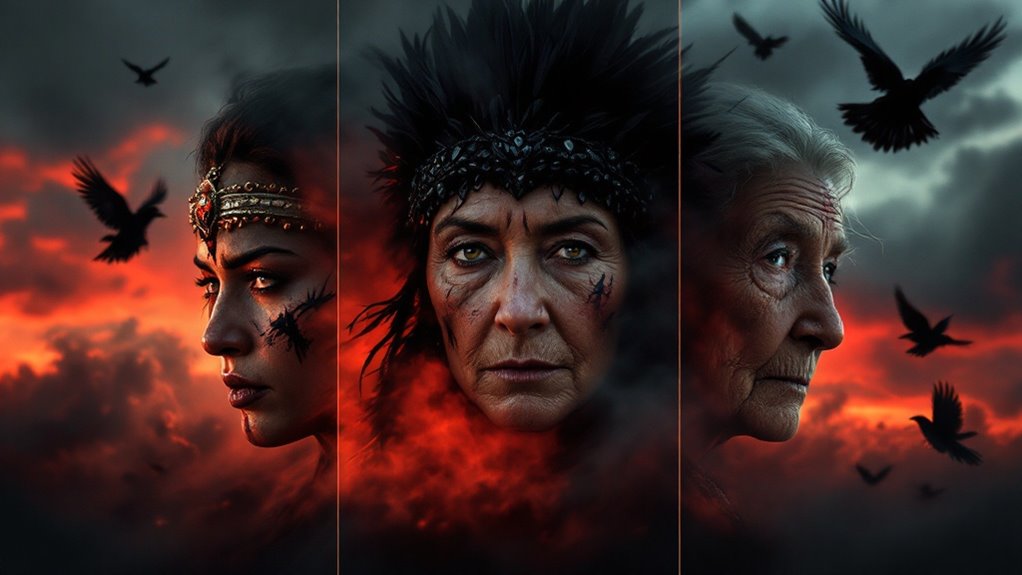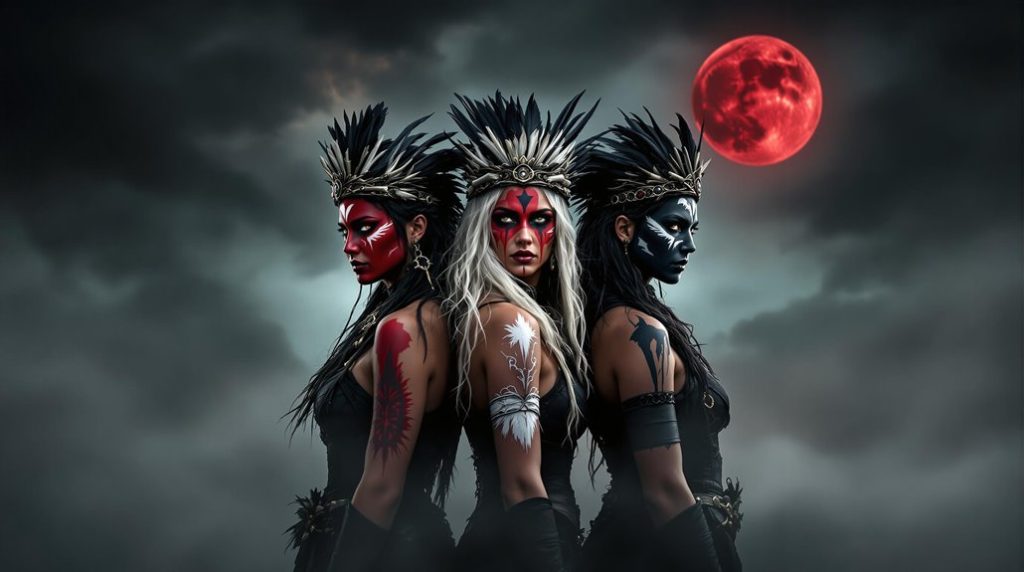I've discovered that the ancient Celts never viewed the Morrigan as a singular war goddess, but rather as a shifting triad of energies that dance through every battlefield like dark sisters of fate. When I study the old texts, I'm struck by how each face of this divine trinity – Badb, Macha, and Nemain – represents a distinct psychological weapon in warfare's arsenal.
While most know of swords and shields in combat, it's the Morrigan's subtle arts of confusion, protection, and terror that truly determined victory.
The Trinity of Battle Goddesses
Ancient stones whisper of three faces that emerge from the mists of Celtic mythology – Badb, Macha, and Nemain, collectively known as the Morrigan's trinity of battle goddesses. In my studies, I've come to appreciate how each sister carries a unique essence of war's darkest aspects. Badb, the bringer of chaos, sows confusion through enemy ranks, while Macha stands as the protector of sovereignty and territory, ensuring her people's survival. The Celts would often perform sacred rituals and offerings to gain the favor of these powerful deities.
Nemain completes this powerful triad, embodying the raw panic and psychological warfare that can break even the bravest warriors. Together, they form the fearsome Phantom Queen, the Morrigan, who shifts between forms like a raven soaring over battlefields. Through their combined powers, these goddesses have shaped the fates of countless warriors, deciding who rises to glory and who falls to doom.
Origins of The Morrigan
As I delve into Ireland's ancient stones, whispers reveal The Morrigan's emergence among supernatural beings known as the Tuatha Dé Danann. Tracing her lineage to Ernmas, The Morrigan first appeared in the Ulster Cycle, wielding powers that shaped Ireland's spiritual landscape.
Through the mists of time, I've uncovered these core truths about her origins:
- She emerged from a dominant megalithic cult of mothers, manifesting as a goddess in three forms.
- Oweynagat, her sacred site, served as a gateway between the natural world and the supernatural.
- During Samhain, her union with the Dagda defined destiny. Her appearance as an old hag transformed to beauty after their coupling sealed the sacred ritual.
- Her presence on the battlefield, manifesting as a shapeshifting raven, marked her sovereign power over war.
The Morrigan's legacy transcended mythology, becoming a symbol of transformation and power for those seeking liberation.
War and Prophecy

On the battlefield, The Morrigan shares secrets about her formidable powers – her ability to shape war through prophecy. Through my studies, I've learned how she transcends mere observation, actively influencing the fate of warriors with her foretelling. Whether she appears as a crow or a warrior-queen, she's not just watching – she's actively weaving destiny itself. She delivers oracular pronouncements that change the course of battles and heroes' lives.
The Morrigan's prophecies carry dual edges – doom for some, victory for others. I've discovered that her visions extend beyond bloodshed into times of peace and renewal. When she addresses warriors before battle, she doesn't just predict what's to come – she transforms their fate. Through her three aspects, she embodies the complexity of war: destruction, protection, and sovereignty. As a harbinger, she understands that every battle fought leads to either freedom or chains. Her prophecies guide those brave enough to listen.
Shapeshifting Powers and Influence
I've witnessed Morrigan's mastery of shapeshifting many times. It stands as a testament to her immense influence over war and fate. She can take various forms – from a raven to an eel, a wolf to a heifer. Each transformation serves her divine purpose in battle and prophecy. Through these metamorphoses, she weaves complex webs of destiny, especially in her interactions with the legendary Cú Chulainn.
Here's a deeper look at the meanings behind her shapeshifting powers:
- The raven form symbolizes her role as harbinger of war and death
- Animal transformations represent her control over nature's forces
- The hag appearance tests heroes' worth through sacred trials
- Multiple forms reflect her trinity aspect as death, fate, and sovereignty
Her ability to change form isn't just a simple trick – it embodies war's ever-changing face and fate's fluid nature.
Ancient Celtic Battlefield Presence

Celtic warriors were a force to be reckoned with on the ancient battlefield. Their supremacy wasn't just down to brute strength – it was a combination of physical skill, psychological warfare, and spiritual practices.
These fighters were highly organized, with infantry wielding swords and shields in tight formation while cavalry utilized the Trimarcisia system – a deadly three-man team. But it was as much about mental fortitude as physical prowess. The Celts were masters of using fear as a weapon. Their blood-curdling battle cries and blasts of horns would strike terror into their enemies, while their imposing appearance and calculated movements were all part of a tactical bid to intimidate.
But there was more to their success than mere aggression. The warriors had a deep spiritual belief system, which they drew upon for strength. Before each battle, they would invoke the power of the Morrigan – a goddess associated with war and fate. They made offerings of weapons and trophies taken from vanquished foes, believing this would secure divine favor on the battlefield.
This potent blend of fighting skill, psychological dominance, and spiritual power made the Celtic warriors a formidable force in ancient times.
Frequently Asked Questions
How Do the Three Faces Communicate With Each Other During Battle?
We share a psychic bond in battle. My minds move in sync, trading thoughts through osmosis. We slip into each other's shadows, merge into one fearsome form, weaving our will into a single lethal tapestry. No words are needed. We know what the other thinks, desires, fears. We are one, and moving as one, we lay waste to all who stand in our way.
What Offerings Were Traditionally Made to Appease the Morrigan's Three Faces?
To truly understand what the Morrigan's three faces required, look to history. Badb, the war-spirit, was appeased through blood offerings and weapons. Macha's sovereignty was satisfied with cattle and land. Nemain, the most chaotic of the three, thrived on fear-inducing rituals and acts that sowed chaos.
In essence, each aspect of the Morrigan demanded very different offerings based on what they represented. Badb was the embodiment of war, so weapons and blood made sense. Macha, tied to sovereignty, required more tangible things like cattle and land. Nemain, associated with chaos, demanded rituals that spread fear and panic.
These distinct offerings reflect the Morrigan's complex nature and the many roles she played in Celtic mythology. By appeasing each aspect appropriately, the ancient Celts believed they could maintain the balance the Morrigan held over life and death, war and peace.
Can Modern Practitioners Work With Individual Faces of the Morrigan Separately?
Building on my knowledge incorporating the Devotional work of practicing Druid Stephanie Woodfield, author of "Celtic Lore and Druidic Rituals," let me share some specifics about individual epithets (or "faces") of the Morrigan in a modern context. There is no singular wrong way to honor the Morrigan as She is a complex Goddess of many aspects. Focus on the attributes and lessons of each:
- Badb – The chaos aspect and harbinger of war brings lessons of upheaval and change. You can call on Badb when you need the strength to break free from stagnant situations. Work with Badb when you are ready to face shadow work and your own inner demons.
- Macha – The sovereignty aspect presiding over land, fertility, and protection. Macha's lessons are about grounding, presence on this earth, and owning your power. Work with Macha when connecting with the cycles of nature and motherhood.
- Nemain – The transformation aspect guiding spirits to the Otherworld. Nemain deals with death and the mysteries of the unknown, facilitating regeneration. Work with this face for deep transformation, facing your fears, and breaking cycles.
Did the Three Faces Ever Disagree or Conflict With Each Other?
The Three Faces of the Celtic Mother Goddess
Through the mists of time, the Celtic Mother Goddess has been revered, her influence weaving through the fabric of ancient societies. She is a powerful symbol of life, death, and rebirth – the eternal cycle. While interpretations may vary, one thing is constant: her triple aspect, three faces joined as one.
But did these faces ever conflict? Did they vie for power or clash in their verschillende rolls? The answer, much like the Goddess herself, remains shrouded in mystery.
The three faces – Maiden, Mother, Crone – represent the stages of a woman's life and the phases of the moon. The maiden is the new moon, full of potential and youthful energy. The mother is the full moon, ripe with the harvest, a nurturing figure. The crone is the waning moon, a wisdom keeper, guiding souls to the underworld. Together, they are the circle of life, each phase necessary.
It's rare to find tales of discord among these aspects. They work in harmony, their individual strengths intertwining to create a powerful whole. The maiden's passion blends with the mother's nurturing, while the crone's wisdom guides them both. They are distinct yet inseparable, three facets of the same goddess.
Scholars have long studied these ancient myths, and most agree – the triple goddess is a union, not a division. Her power lies in the balance, the delicate dance between the maiden, mother, and crone. To separate them would be to unravel the very essence of her being.
In a world where duality often reigns, the triple goddess stands as a testament to unity in diversity. Each face brings something unique, but together, they are unstoppable. Perhaps that is why the Celts revered her so deeply – a reminder that even the most opposing forces can work as one.
How Did Common People Distinguish Between Encounters With Different Faces?
In ancient Celtic mythology, people differentiated between encounters with the various forms of the goddess Morrigan by the distinct attributes each one displayed. Badb was the bringer of battle frenzy and chaos – she would often appear as a crow flying over the battlefield, instilling a mad fervor in the warriors. Macha had a connection to sovereignty and fertility, and was often associated with sacred land, kingship, and productivity. Nemain was perhaps the most fearsome, her unearthly wailing causing enemies to go mad with terror.


